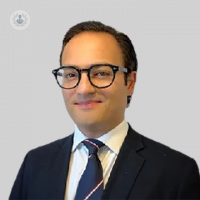Rhinoplasty: common questions and concerns
Written in association with:Rhinoplasty, more commonly known as a "nose job," is one of the most frequently performed cosmetic surgeries worldwide. Whether motivated by a desire to enhance facial aesthetics or address functional issues such as breathing difficulties, many individuals consider this procedure to achieve their desired look or improve their quality of life.
Leading consultant ENT surgeon Mr Saleh Okhovat provides a comprehensive overview of rhinoplasty, addressing common questions and concerns to help you make an informed decision about this transformative surgery.

What is rhinoplasty?
Rhinoplasty, commonly referred to as a "nose job," is a surgical procedure aimed at reshaping the nose. This procedure can be performed for aesthetic reasons, to enhance the appearance of the nose, or for functional reasons, such as improving breathing difficulties caused by structural abnormalities.
Who should consider rhinoplasty?
Patients who might benefit from rhinoplasty include those who are either dissatisfied with the shape, size, or symmetry of their nose and those patients with functional and cosmetic issues with the nose. Common concerns include a prominent hump on the nasal bridge, a bulbous tip, or a nose that is disproportionate to other facial features.
Additionally, individuals who have experienced nasal trauma or have congenital deformities that affect their breathing may find rhinoplasty beneficial. It is important for potential candidates to have realistic expectations and understand that while rhinoplasty can significantly enhance facial harmony, perfection is not always achievable.
How is rhinoplasty performed?
Rhinoplasty is typically performed under general anaesthesia, meaning the patient is asleep during the surgery. The surgeon performs incisions either within the nostrils (closed rhinoplasty) or along the columella, the tissue strip between the nostrils (open rhinoplasty). These incisions allow the surgeon to modify the underlying bone and cartilage to achieve the desired result.
This may involve removing or adding tissue, straightening the nasal bridge, refining the tip, or correcting any deviations in the nasal septum (the partition between the nostrils).
What is the recovery process like?
Post-operative recovery from rhinoplasty varies from patient to patient. Typically, you can expect swelling and bruising around the eyes, which gradually subsides over the first two weeks. It is advisable to take at least one week off work to rest and recover. Most patients can resume light activities within a week but should avoid strenuous activities for several weeks to ensure proper healing.
Your surgeon will provide specific post-operative care instructions, including how to manage discomfort and reduce swelling. Remember that every individual heals differently, so patience and adherence to post-operative care guidelines are key to achieving the desired outcome.
Are there risks involved?
As with any surgical procedure, rhinoplasty carries certain risks. These may include infection, bleeding, or adverse reactions to anaesthesia. Specific risks related to rhinoplasty include nasal obstruction, unsatisfactory aesthetic results, and the potential need for revision surgery. For more detailed review, please see separate article on risks associated with Rhinoplasty surgery. It is crucial to discuss these risks thoroughly with your surgeon before deciding to proceed with the operation.
What should you expect from the consultation?
During the initial consultation, the surgeon will evaluate your nasal structure and discuss your goals for the surgery. Photographs may be taken to assist in planning the procedure. This is an excellent opportunity to ask questions and express any concerns you may have. The surgeon will explain the surgical approach, potential risks, and expected outcomes.
It is common practice for Mr Okhovat to arrange two consultations prior to undergoing rhinoplasty surgery to ensure the best possible outcome. The first consultation allows the patient to discuss their goals, concerns, and medical history with the surgeon. It also gives the surgeon an opportunity to evaluate the patient's nasal structure, obtain clinical photographs and determine the feasibility of the procedure. Written information is provided for the patient to review and consider in their own time whilst providing a “cool off” period so that the patient can take the time to consider their options.
Following this initial consultation, a second meeting provides a chance for further discussion, clarification of expectations, and finalizing the surgical plan. This thorough process helps build trust between the patient and surgeon, ensures realistic expectations, and increases the likelihood of achieving the desired results while minimizing risks.
How to choose the right surgeon?
Selecting a qualified and experienced surgeon is paramount to achieving a successful outcome. Look for a surgeon who is board-certified and has extensive experience in performing rhinoplasty. Examining before-and-after photos of past patients and reading testimonials can offer valuable insights into the surgeon.
Considering rhinoplasty is a significant decision that can impact both your appearance and self-confidence. Thorough research and consultation with a qualified surgeon are essential steps to ensure that you are well-informed and comfortable with your choice.
If you are considering a rhinoplasty and would like to book a consultation with Mr Okhovat, do not hesitate to do so by visiting his Top Doctors profile today.


